Spatiotemporal Variations in Daytime and Night-Time Precipitation on the Yunnan–Guizhou Plateau from 1960 to 2017
Abstract
:1. Introduction
2. Materials and Methods
2.1. Study Area and Data
2.2. Trend Analysis and Change Rate
3. Results and Discussion
3.1. Temporal Changes in Diurnal Precipitation
3.1.1. Changes in Rainy Season and Dry Season of Diurnal Precipitation
3.1.2. Annual Variations in Daytime and Night-Time Precipitation
3.1.3. Interdecadal Variations in Daytime and Night-Time Precipitation
3.2. Spatial Changes in Diurnal Precipitation
3.2.1. Spatial Distributions of Daytime and Night-Time Precipitation Change Rates
3.2.2. Spatial Variation in the Gradients of Daytime and Night-Time Precipitation
3.3. Characteristics of Extreme Daytime and Night-Time Precipitation
3.4. Possible Causes Related to the Distribution of Diurnal Precipitation
4. Conclusions
Author Contributions
Funding
Acknowledgments
Conflicts of Interest
References
- Milly, P.C.D.; Dunne, K.A.; Vecchia, A.V. Global pattern of trends in streamflow and water availability in a changing climate. Nature 2005, 438, 347–350. [Google Scholar] [CrossRef] [PubMed]
- Busico, G.; Ntona, M.M.; Carvalho, S.C.P.; Patrikaki, P.; Voudouris, K.; Kazakis, N. Simulating future groundwater recharge in coastal and inland catchments. Water Resour. Manag. 2021, 35, 3617–3632. [Google Scholar] [CrossRef]
- Cheng, Q.P.; Gao, L.; Zuo, X.A.; Zhong, F.L. Statistical analyses of spatial and temporal variabilities in total, daytime, and night-time precipitation indices and of extreme dry/wet association with large-scale circulations of Southwest China, 1961–2016. Atmos. Res. 2019, 219, 166–182. [Google Scholar] [CrossRef]
- Bao, X.H.; Zhang, F.Q. Impacts of the mountain-plains solenoid and cold pool dynamics on the diurnal variation of warm season precipitation over northern China. Atmos. Chem. Phys. 2013, 13, 6965–6982. [Google Scholar]
- Carbone, R.E.; Tuttle, J.D.; Ahijevych, D.A.; Trier, S.B. Inferences of predictability associated with warm season precipitation episodes. J. Atmos. Sci. 2002, 59, 2033–2056. [Google Scholar] [CrossRef] [Green Version]
- Niu, X.R.; Tang, J.P.; Wang, S.Y.; Fu, C.B.; Chen, D. On the sensitivity of seasonal and diurnal precipitation to cumulus parameterization over CORDEX-EA-II. Clim. Dyn. 2020, 54, 373–393. [Google Scholar] [CrossRef]
- Yu, R.C.; Zhou, T.J.; Xiong, A.Y.; Zhu, Y.J.; Li, J.M. Diurnal variation of summer precipitation over contiguous China. J. Geophys. Res. 2007, 34, 223–234. [Google Scholar] [CrossRef] [Green Version]
- Zhu, L.M.; Liu, J.Z.; Zhu, A.X.; Sheng, M.L.; Duan, Z. Spatial distribution of diurnal rainfall variation in summer over China. J. Hydrometeorol. 2018, 19, 667–678. [Google Scholar] [CrossRef]
- Zhang, H.; Zhai, P.M. Temporal and spatial characteristics of extreme hourly precipitation over eastern China in the warm season. Adv. Atmos. Sci. 2011, 28, 1177–1183. [Google Scholar] [CrossRef]
- Zheng, Y.G.; Gong, Y.D.; Chen, J.; Tian, F.Y. Warm-season diurnal variations of total, stratiform, convective, and extreme hourly precipitation over Central and Eastern China. Adv. Atmos. Sci. 2019, 36, 143–159. [Google Scholar] [CrossRef]
- He, H.Z.; Zhang, F.Q. Diurnal variations of warm-season precipitation over northern China. Mon. Weather Rev. 2010, 138, 1017–1025. [Google Scholar] [CrossRef]
- Jiang, Z.; Zhang, D.L.; Xia, R.; Qian, T. Diurnal variations of pre-summer rainfall over Southern China. J. Clim. 2017, 30, 755–773. [Google Scholar] [CrossRef]
- Liu, X.M.; Zhang, M.J.; Wang, S.J.; Wang, J.; Zhao, P.P.; Zhou, P.P. Assessment of diurnal variation of summer precipitation over the Qilian Mountains based on an hourly merged dataset from 2008 to 2014. J. Geogr. Sci. 2017, 27, 326–336. [Google Scholar] [CrossRef]
- Huang, W.R.; Chang, Y.H. Characteristics and mechanisms of the diurnal variation of winter precipitation in Taiwan. Int. J. Climatol. 2018, 38, 3058–3068. [Google Scholar] [CrossRef]
- Chen, S.L.; Yan, Y.; Liu, G.; Fang, D.X.; Wu, Z.; He, J.; Tang, J.P. Spatiotemporal characteristics of precipitation diurnal variations in Chongqing with complex terrain. Theor. Appl. Climatol. 2019, 137, 1217–1231. [Google Scholar] [CrossRef]
- Zhao, Y.; Wang, M.Z.; Li, J.; Yang, X.Y.; Zhang, N.; Chen, H. Diurnal variations in summer precipitation over the Yellow River Basin. Adv. Meteorol. 2019, 2019, 2482656. [Google Scholar] [CrossRef]
- Xue, Y.; Mao, W.S.; Zhang, H.B.; Gong, Y.F. Characteristics of the Precipitation Changes in the Rainy Season in the Yunnan-Guizhou Plateau. J. Chengdu. Univ. Inf. Technol. 2020, 35, 566–572. (In Chinese) [Google Scholar]
- Qin, N.X.; Chen, X.; Fu, G.B.; Zhai, J.Q.; Xue, X.W. Precipitation and temperature trends for the Southwest China: 1960–2007. Hydrol. Process. 2010, 24, 733–3744. [Google Scholar] [CrossRef]
- Li, Z.X.; He, Y.Q.; Wang, C.F.; Wang, X.F.; Xin, H.J.; Zhang, W.; Cao, W.H. Spatial and temporal trends of temperature and precipitation during 1960–2008 at the Hengduan Mountains, China. Quat. Int. 2011, 236, 127–142. [Google Scholar] [CrossRef]
- Yuan, W.H.; Hu, X.L.; Tian, Q. Regional differences in rainfall frequency and amount over southwestern China. Atmos. Ocean. Sci. Lett. 2019, 12, 313–319. [Google Scholar] [CrossRef] [Green Version]
- Li, Z.X.; He, Y.Q.; Wang, P.Y.; Theakstone, W.H.; An, W.L.; Wang, X.F.; Lu, A.G.; Zhang, W.; Cao, W.H. Changes of daily climate extremes in southwestern China during 1961–2008. Glob. Planet. Chang. 2012, 80–81, 255–272. [Google Scholar]
- Liu, M.X.; Xu, X.L.; Sun, A. Decreasing spatial variability in precipitation extremes in southwestern China and the local/large-scale influencing factors. J. Geophys. Res. Atmos. 2015, 120, 6480–6488. [Google Scholar] [CrossRef]
- Zhang, C. Moisture sources for precipitation in Southwest China in summer and the changes during the extreme droughts of 2006 and 2011. J. Hydrol. 2020, 591, 12533. [Google Scholar] [CrossRef]
- Zhang, K.X.; Pan, S.M.; Cao, L.G.; Wang, Y.; Zhao, Y.F.; Zhang, W. Spatial distribution and temporal trends in precipitation extremes over the Hengduan Mountains region, China, from 1961 to 2012. Quat. Int. 2014, 349, 346–356. [Google Scholar] [CrossRef]
- Yuan, S.J.; Miao, Q.L.; Gu, X.P.; Qiu, X.F.; Zhou, T.; Kang, W.M. Analysis on the spring drought in the karst region of Yunnan and Guizhou Plateau in China. Sci. Geogr. Sin. 2007, 27, 796–800. (In Chinese) [Google Scholar]
- Yan, Y.; Dai, Q.; Yuan, Y.; Peng, X.; Zhao, L.; Yang, J. Effects of rainfall intensity on runoff and sediment yields on bare slopes in a karst area, SW China. Geoderma 2018, 330, 30–40. [Google Scholar] [CrossRef]
- Nyeko-Ogiramoi, P.; Willems, P.; Ngirane-Katashaya, G. Trend and variability in observed hydrometeorological extremes in the Lake Victoria basin. J. Hydrol. 2013, 489, 56–73. [Google Scholar] [CrossRef]
- Gu, Z.J.; Duan, X.W.; Liu, B.; Hu, J.M.; He, J.N. The spatial distribution and temporal variation of rainfall erosivity in the Yunnan Plateau, Southwest China: 1960–2012. Catena 2016, 145, 291–300. [Google Scholar]
- Yan, H.M.; Li, Q.Q.; Sun, C.H.; Yuan, Y.; Li, D. Criterion for determining the onset and end of the rainy season in Southwest China. Chin. J. Atmos. Sci. 2013, 37, 1111–1128. (In Chinese) [Google Scholar]
- Deng, H.J.; Guo, B.; Cao, Y.Q.; Chen, Z.S.; Zhang, Y.Q.; Chen, X.W.; Gao, L.; Chen, Y.; Liu, M.B. Spatial and temporal patterns of daytime and night-time precipitation in China during 1961–2016. Geogr. Res. Aust. 2020, 39, 2415–2426. (In Chinese) [Google Scholar]
- Liu, M.H.; Qin, N.X.; Chen, Y.L.; Huang, J.L. Study on change characteristics of non-effective precipitation days in Southwest China from 1960 to 2016. Pearl River 2020, 41, 21–29. (In Chinese) [Google Scholar]
- Lu, J.Y.; Yan, J.P.; Cao, Y.W. Spatial distribution characteristics of precipitation and flood index in Southwestern China during 1961–2015. Resour. Environ. Yangtze Basin 2017, 26, 1711–1720. (In Chinese) [Google Scholar]
- Du, Y.; Chen, G.; Han, B.; Bai, L.Q.; Li, M.H. Convection initiation and growth at the coast of South China. Part II: Effects of the terrain, coastline and cold pools. Mon. Weather Rev. 2020, 148, 3871–3892. [Google Scholar] [CrossRef]
- Lac, C.; Lafore, J.P.; Redelsperger, J.L. Role of gravity waves in triggering deep convection during TOGA COARE. J. Atmos. Sci. 2002, 59, 1293–1316. [Google Scholar] [CrossRef]
- Peng, D.W.; Zhou, Q.W.; Xie, X.M.; Wei, X.C.; Tang, X.; Yan, W.H. Effect of underlying surface factors on water use efficiency in the karst area. Prog. Geogr. 2021, 40, 2086–2100. (In Chinese) [Google Scholar] [CrossRef]
- Zeng, W.; Yu, Z.; Wu, S.H.; Qin, J.B. Changes in annual, seasonal and monthly precipitation events and their link with elevation in Sichuan province, China. Int. J. Climatol. 2016, 36, 2303–2322. [Google Scholar] [CrossRef]
- Li, L.L.; Li, J.; Chen, H.; Yu, R.C. Diurnal variations of summer precipitation over the Qilian Mountains in northwest China. J. Meteorol. Res. 2019, 33, 18–30. [Google Scholar] [CrossRef]
- Tao, J.; Dong, J.X.; Liu, G.L.; Zhang, G.L.; Zhu, J.T.; Song, W.J.; Wang, C.D.; Chen, A.G.; Wang, S.S. Characteristics of temperature and precipitation change along increasing elevation in different agriculture regions of Southwest China. Chin. J. Agrometeorol. 2016, 37, 379–389. (In Chinese) [Google Scholar]
- Yu, H.; Wang, L.; Yang, R.; Yang, M.L.; Gao, R. Temporal and spatial variation of precipitation in the Hengduan Mountains region in China and its relationship with elevation and latitude. Atmos. Res. 2018, 213, 1–16. [Google Scholar] [CrossRef]
- Bookhagen, B.; Burbank, D.W. Topography, relief, and TRMM-derived rainfall variations along the Himalaya. Geophys. Res. Lett. 2006, 33, 153–172. [Google Scholar]
- Salerno, F.; Guyennon, N.; Thakuri, S.; Viviano, G.; Romano, E.; Vuillermoz, E.; Cristofanelli, P.; Agrillo, G.; Ma, Y.; Tartari, G. Weak precipitation, warm winters and springs impact glaciers of south slopes of Mt. Everest (central Himalaya) in the last 2 decades (1994–2013). Cryosphere 2015, 9, 1229–1247. [Google Scholar] [CrossRef] [Green Version]
- Feng, Y.; Zhao, X.Y. Changes in spatiotemporal pattern of precipitation over China during 1980–2012. Environ. Earth Sci. 2015, 73, 1649–1662. [Google Scholar] [CrossRef]
- Liu, B.J.; Li, Y.; Chen, J.F.; Chen, X.H. Long-term change in precipitation structure over the karst area of Southwest China. Int. J. Climatol. 2016, 36, 2417–2434. [Google Scholar] [CrossRef] [Green Version]
- Li, L. Temporal and spatial characteristics of different rainfall intensity changes in China under changing environment. Water Resour. Power 2021, 39, 8–11. (In Chinese) [Google Scholar]
- Levizzani, V.; Pinelli, F.; Pasqui, M.; Melani, S.; Laing, A.G.; Carbone, R.E. A 10-year climatology of warm-season cloud patterns over Europe and the Mediterranean from Meteosat IR observations. Atmos. Res. 2010, 97, 555–576. [Google Scholar] [CrossRef]
- Fu, X.S.; Yang, X.Q.; Sun, X.G. Spatial and Diurnal variations of summer hourly rainfall over three super city clusters in eastern China and their possible link to the urbanization. J. Geophys. Res. Atmos. 2019, 124, 5445–5462. [Google Scholar] [CrossRef]
- Miao, C.Y.; Duan, Q.Y.; Sun, Q.H.; Lei, X.H.; Li, H. Non-uniform changes in different categories of precipitation intensity across China and the associated large-scale circulations. Environ. Res. Lett. 2019, 14, 025004. [Google Scholar] [CrossRef]
- Easterling, D.R.; Evans, J.L.; Groisman, P.Y.; Karl, T.R.; Kunkel, K.E.; Ambenje, P. Observed variability and trends in extreme climate events: A brief review. Bull. Am. Meteorol. Soc. 2000, 81, 417–426. [Google Scholar] [CrossRef] [Green Version]
- Zhang, C.; Tang, Q.H.; Chen, D.L.; Li, L.F.; Liu, X.C.; Cui, H.J. Tracing changes in atmospheric moisture supply to the drying Southwest China. Atmos. Chem. Phys. 2017, 17, 1–19. [Google Scholar] [CrossRef] [Green Version]
- Zhang, C.; Wu, S.H. An analysis on moisture source of extreme precipitation in Southwest China in summer. J. Nat. Resour. 2021, 36, 1186–1194. (In Chinese) [Google Scholar] [CrossRef]
- Zhang, D.; Wang, W.S.; Liang, S.Q.; Wang, S.J. Spatiotemporal variations of extreme precipitation events in the Jinsha River Basin, Southwestern China. Adv. Meteorol. 2020, 3, 1–13. [Google Scholar] [CrossRef]
- You, Q.L.; Kang, S.C.; Aguilar, E.; Pepin, N.; Flugel, W.A.; Yan, Y.P.; Xu, Y.W.; Zhang, Y.J.; Huang, J. Changes in daily climate extremes in China and their connection to the large scale atmospheric circulation during 1961–2003. Clim. Dyn. 2011, 36, 2399–2417. [Google Scholar] [CrossRef]
- Wu, R.G.; Hu, Z.Z.; Kirtman, B. Evolution of ENSO-related rainfall anomalies in East Asia. J. Clim. 2003, 16, 3742–3758. [Google Scholar] [CrossRef]
- Takahashi, H.G.; Yoshikane, T.; Hara, M.; Takata, K.; Yasunari, T. High-resolution modelling of the potential impact of land surface conditions on regional climate over indochina associated with the diurnal precipitation cycle. Int. J. Climatol. 2010, 30, 2004–2020. [Google Scholar] [CrossRef]
- Hohenegger, C.; Brockhaus, P.; Bretherton, C.S.; Schär, C. The soil moisture-precipitation feedback in simulations with explicit and parameterized convection. J. Clim. 2009, 22, 5003–5020. [Google Scholar] [CrossRef]
- Zhou, X.; Geerts, B. The influence of soil moisture on the planetary boundary layer and on cumulus convection over an isolated mountain. Part I: Observations. Mon. Weather Rev. 2013, 141, 1061–1078. [Google Scholar] [CrossRef]
- Li, X. Spatial and Temporal Characteristics of Soil Drought Change in China during the Past 60 Years. Ph.D. Thesis, Nanjing University of Information Science & Technology, Nanjing, China, 2021. [Google Scholar]
- Bonan, G.B. Forests and climate change: Forcings, feedbacks, and the climate benefits of forests. Science 2008, 320, 1444–1449. [Google Scholar] [CrossRef] [Green Version]
- Hou, W.J.; Gao, J.; Wu, S.H.; Dai, E.F. Interannual variations in growing-season NDVI and its correlation with climate variables in the Southwestern Karst region of China. Remote Sens. 2015, 7, 11105–11124. [Google Scholar] [CrossRef] [Green Version]
- IPCC. Climate change 2013: The physical science basis. In Contribution of Working Group I to the Fifth Assessment Report of the Intergovernmental Panel on Climate Change; Cambridge University Press: Cambridge, UK, 2013; pp. 35–69. [Google Scholar]
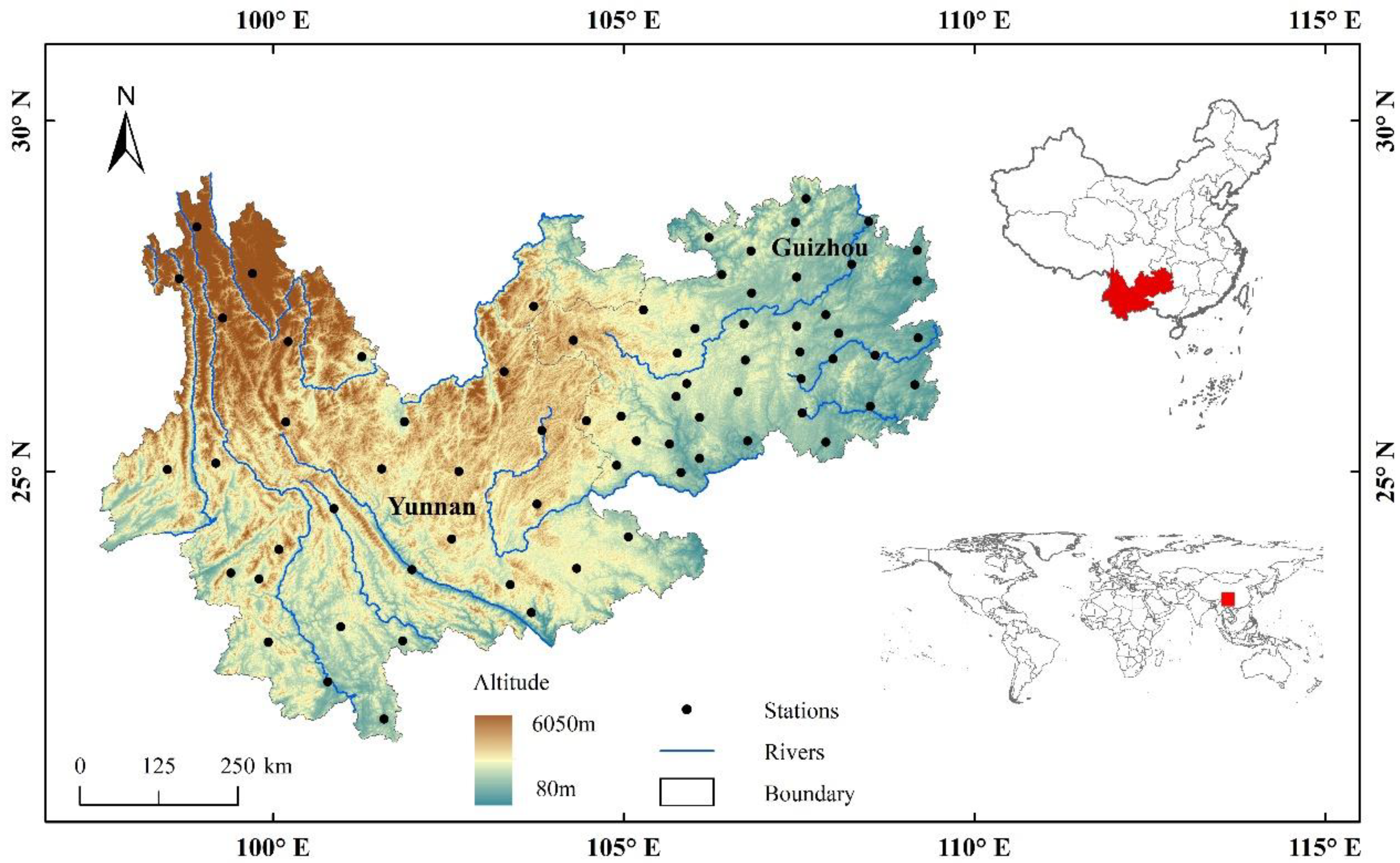
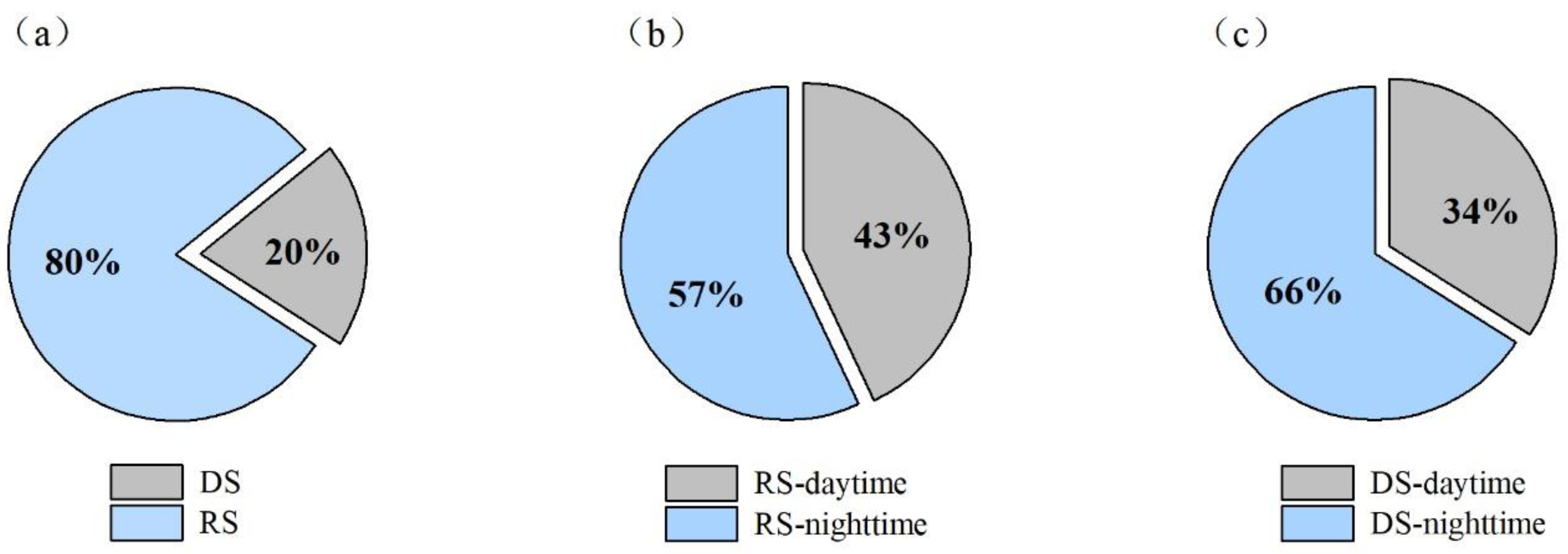
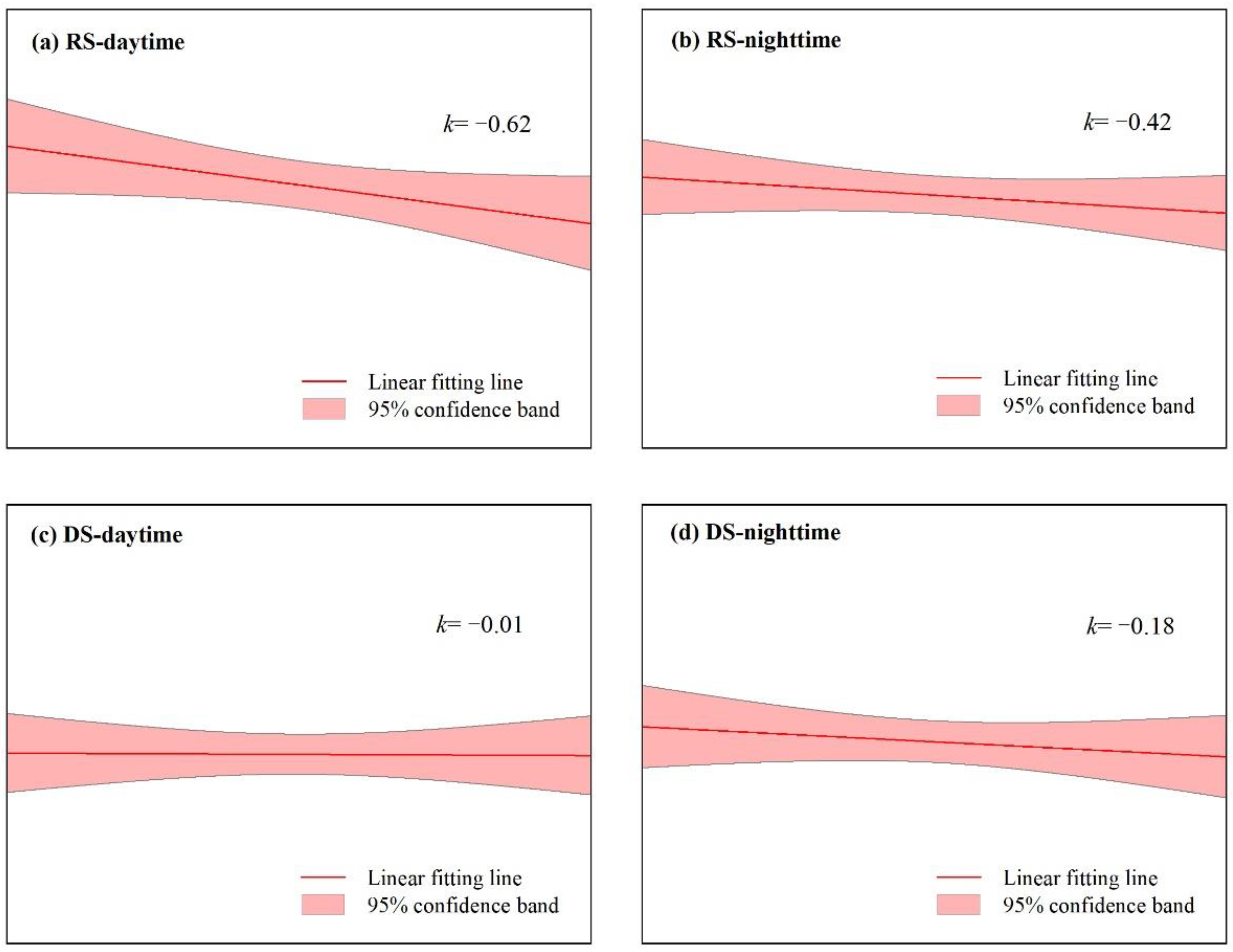
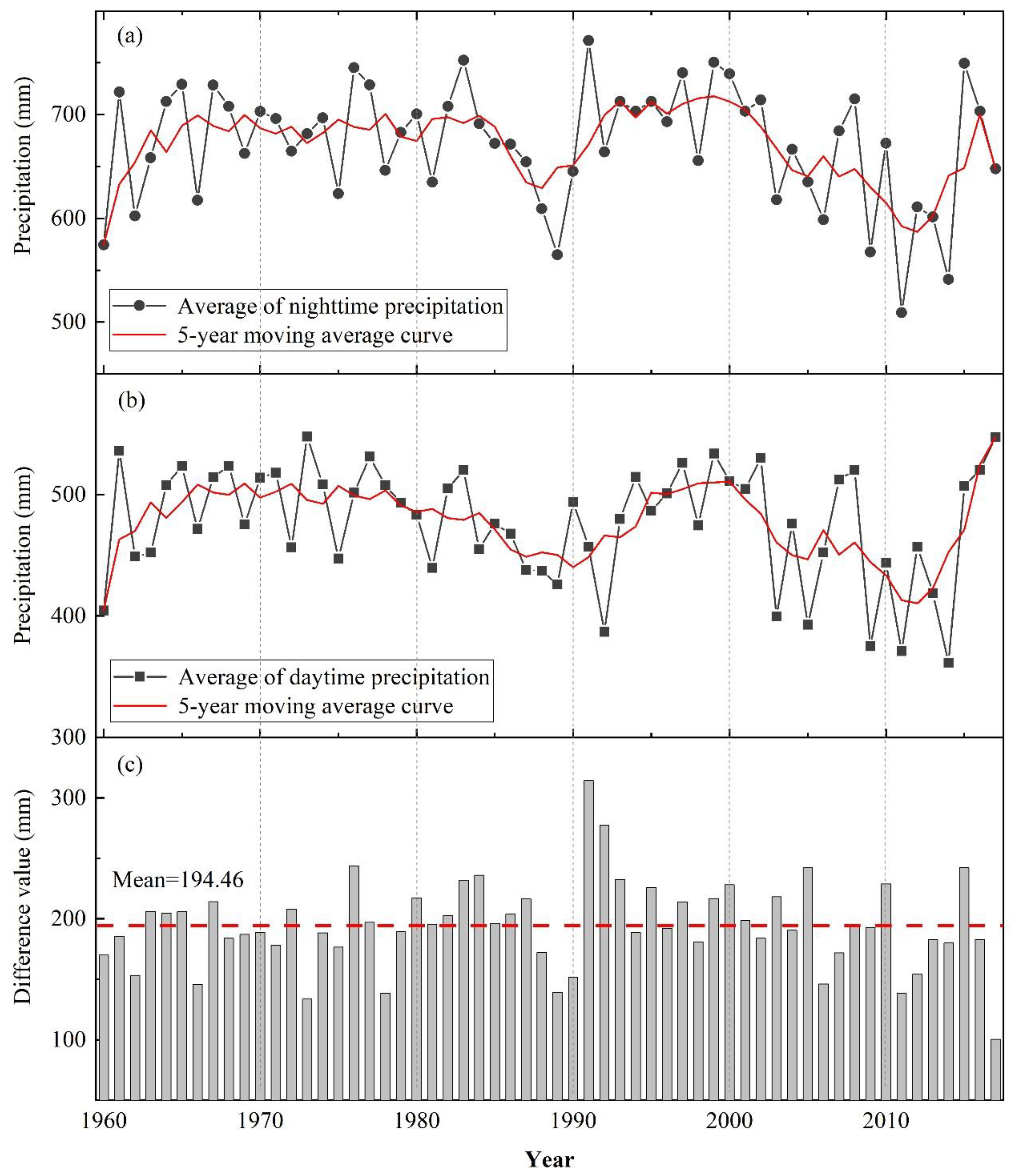
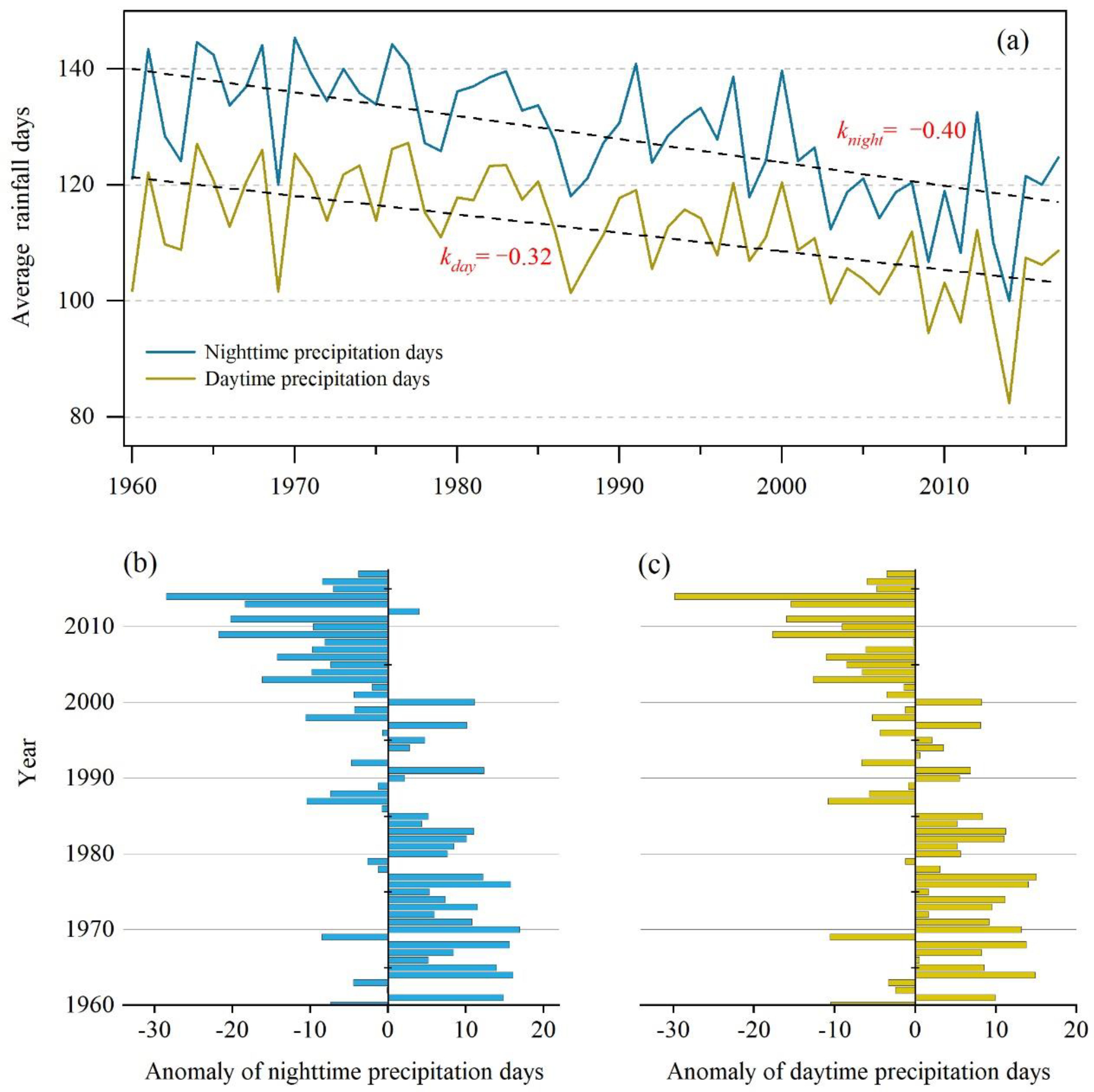

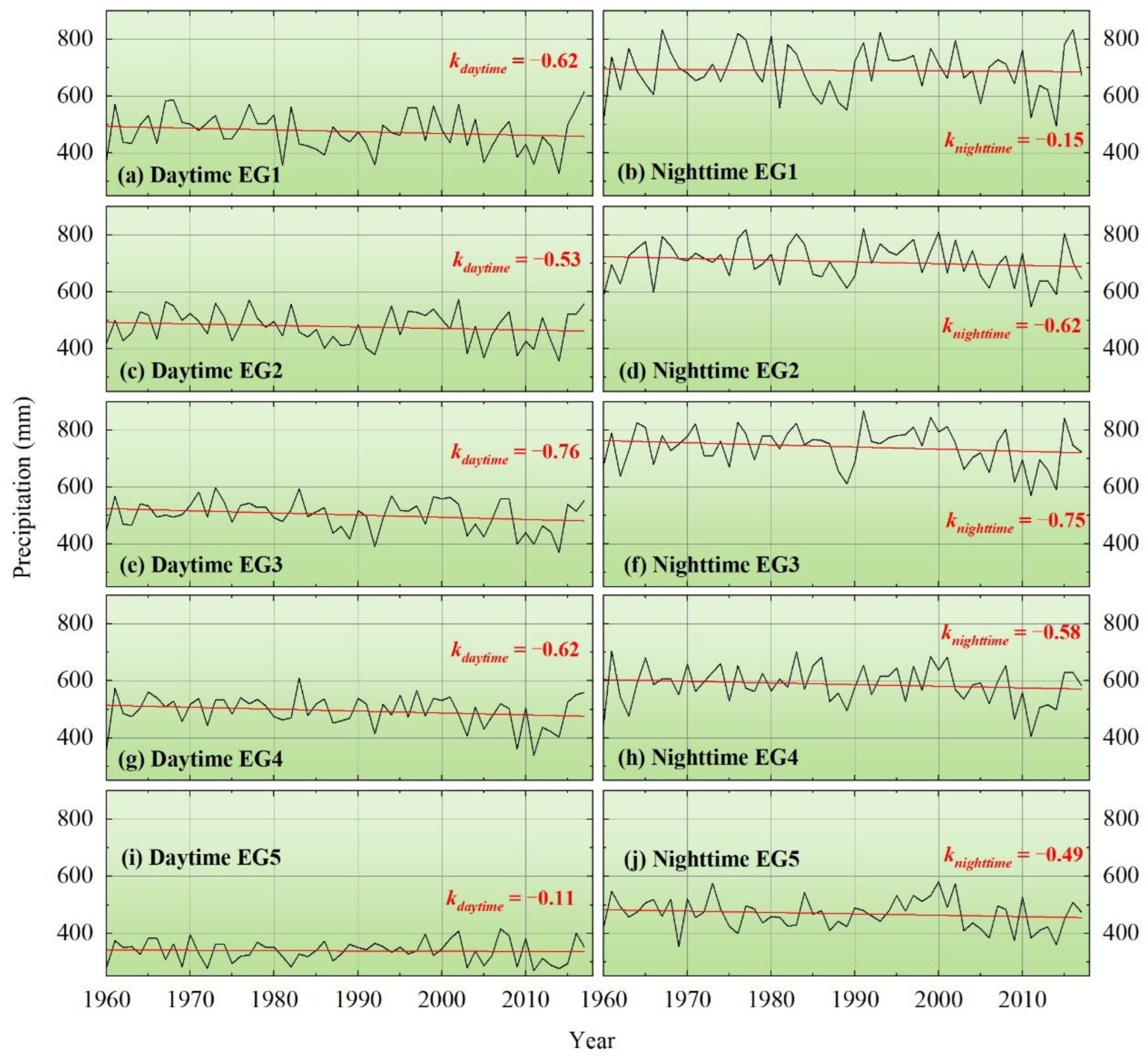

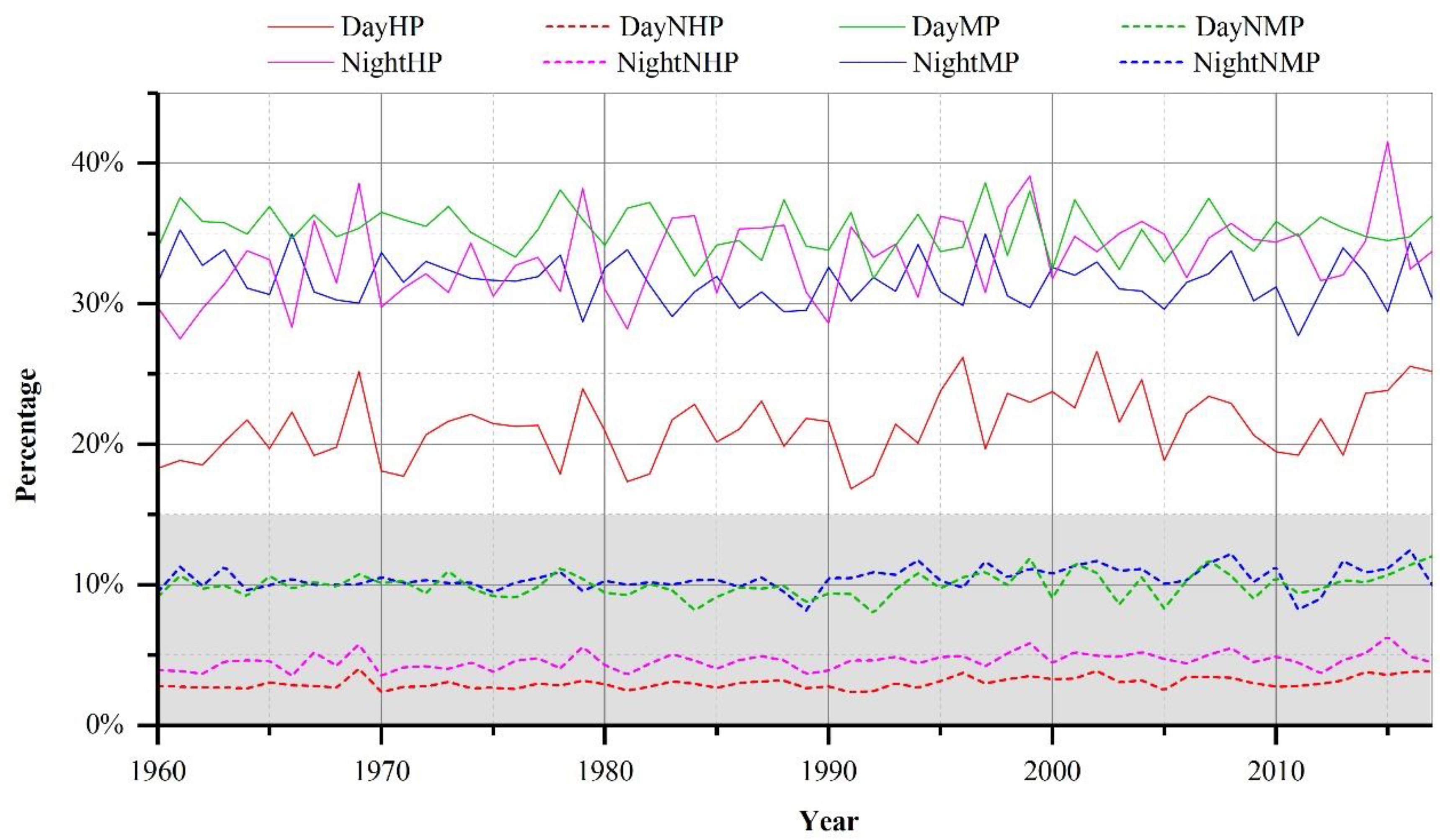
| RS-Daytime | RS-Nighttime | DS-Daytime | DS-Nighttime | |
|---|---|---|---|---|
| Linear change rate | −0.62 mm/yr | −0.43 mm/yr | −0.01 mm/yr | −0.18 mm/yr |
| p-value | 0.06 | 0.27 | 0.94 | 0.4 |
| 1960s | 1970s | 1980s | 1990s | 2000s | 2010s | 1960–2017 | |
|---|---|---|---|---|---|---|---|
| daytime | 57.76 | −5.18 | −60.95 | 73.75 | −68.48 | 186.31 | −6.30 |
| night-time | 73.95 | −5.65 | −116.82 | 1.04 | −102.90 | 137.00 | −6.12 |
| Items | AG1 (<500 m) | AG2 (500–1000 m) | AG3 (1000–1500 m) | AG4 (1500–2000 m) | AG5 (>2000 m) |
|---|---|---|---|---|---|
| Number of stations | 9 | 19 | 24 | 15 | 6 |
| Proportion | 12% | 26% | 33% | 21% | 8% |
| Average of daytime annual precipitation (mm) | 475.21 | 476.87 | 501.99 | 494.39 | 337.99 |
| Average of night-time annual precipitation (mm) | 689.34 | 705.43 | 741.19 | 587.38 | 468.62 |
| Type | ONI | SOI | MEI | |
|---|---|---|---|---|
| All Time Period | Daytime precipitation | 0.02 | 0.03 | 0.03 |
| Nighttime precipitation | −0.02 | −0.03 | −0.02 | |
| Daily precipitation | 0.07 | 0.10 *** | 0.09 ** | |
| El Niño Time Period | Daytime precipitation | 0.62 *** | −0.64 *** | 0.44 * |
| Nighttime precipitation | 0.68 *** | −0.70 *** | 0.54 ** | |
| Daily precipitation | 0.67 *** | −0.69 *** | 0.51 ** | |
| La Niña Time Period | Daytime precipitation | −0.45 * | 0.03 | −0.37 |
| Nighttime precipitation | −0.55 ** | 0.13 | −0.45 * | |
| Daily precipitation | −0.50 * | 0.08 | −0.41 |
Publisher’s Note: MDPI stays neutral with regard to jurisdictional claims in published maps and institutional affiliations. |
© 2022 by the authors. Licensee MDPI, Basel, Switzerland. This article is an open access article distributed under the terms and conditions of the Creative Commons Attribution (CC BY) license (https://creativecommons.org/licenses/by/4.0/).
Share and Cite
Zhu, D.; Yang, Q.; Xiong, K.; Xiao, H. Spatiotemporal Variations in Daytime and Night-Time Precipitation on the Yunnan–Guizhou Plateau from 1960 to 2017. Atmosphere 2022, 13, 415. https://doi.org/10.3390/atmos13030415
Zhu D, Yang Q, Xiong K, Xiao H. Spatiotemporal Variations in Daytime and Night-Time Precipitation on the Yunnan–Guizhou Plateau from 1960 to 2017. Atmosphere. 2022; 13(3):415. https://doi.org/10.3390/atmos13030415
Chicago/Turabian StyleZhu, Dayun, Qian Yang, Kangning Xiong, and Hua Xiao. 2022. "Spatiotemporal Variations in Daytime and Night-Time Precipitation on the Yunnan–Guizhou Plateau from 1960 to 2017" Atmosphere 13, no. 3: 415. https://doi.org/10.3390/atmos13030415
APA StyleZhu, D., Yang, Q., Xiong, K., & Xiao, H. (2022). Spatiotemporal Variations in Daytime and Night-Time Precipitation on the Yunnan–Guizhou Plateau from 1960 to 2017. Atmosphere, 13(3), 415. https://doi.org/10.3390/atmos13030415





